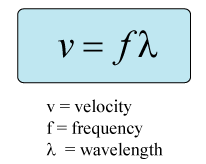So - Waves.....
We spoke about energy. Energy can, as it turns out, travel in waves. In fact, you can think of a wave as a traveling disturbance, capable of carrying energy.
There are several wave characteristics (applicable to most conventional waves) that are useful to know:
amplitude - the "height" of the wave, from equilibrium (or direction axis of travel) to maximum position above or below
crest - peak (or highest point) of a wave
trough - valley (or lowest point) of a wave
wavelength (lambda - see picture 2 above) - the length of a complete wave, measured from crest to crest or trough to trough (or distance between any two points that are in phase - see picture 2 above). Measured in meters (or any units of length).
frequency (f) - literally, the number of complete waves per second. The unit is the cycle per second, usually called: hertz (Hz)
wave speed (v) - the rate at which the wave travels. Same as regular speed/velocity, and measured in units of m/s (or any unit of velocity). It can be calculated using a simple expression:
There are 2 primary categories of waves:
Mechanical – these require a medium (e.g., sound, guitar strings, water, etc.)
Electromagnetic – these do NOT require a medium and, in fact, travel fastest where is there is nothing in the way (a vacuum). All e/m waves travel at the same speed in a vacuum (c, the speed of light):
c = 3 x 10^8 m/s
First, the electromagnetic (e/m) waves:
General breakdown of e/m waves from low frequency (and long wavelength) to high frequency (and short wavelength):
Radio
Microwave
IR (infrared)
Visible (ROYGBV)
UV (ultraviolet)
X-rays
Gamma rays
In detail, particularly the last image:
Again, don't forget that the primary wave variables are related by the expression:
speed = frequency x wavelength
(Note that 'l' should be the Greek symbol 'lambda', if it does not already show up as such.)
For e/m waves, the speed is the speed of light, so the expression becomes:
Note that for a given medium (constant speed), as the frequency increases, the wavelength decreases.
Let us examine "harmonics", visible on a string (as demonstrated in class). Harmonics are wave shapes produced that have a maximum amplitude under given conditions (tension in string, length of string, composition of string, etc.). Every stretched string has a particular lowest frequency at which it will naturally resonate or vibrate. However, there are also higher frequencies that will also give "harmonics" - basically, pretty wave shapes. These higher frequencies are integer multiples of the lowest frequency.
So, if the frequency of the lowest frequency is 10 Hz (for an N = 1 harmonic), the next harmonic (N = 2) occurs at 20 Hz. N = 3 is at 30 Hz, and so on.














